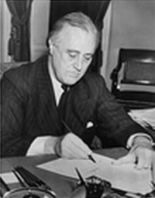This Week in History
March 11-March 18, 1933
Emergency Banking Act
March 2010
 Franklin D. Roosevelt |
President Franklin Delano Roosevelt took office March 3, in a situation where more than 25% of the American workforce were officially unemployed, banks and business were failing hand over fist, and the nation was enmired in depression, both physically and in spirit. He did not wait an instant, but moved vigorously to restore confidence in the U.S. banking system, and to set the basis for reviving the U.S. economy. Under his bold leadership, this was the most dense period of executive action in U.S. history, and represented the first steps to reviving the principle of the General Welfare in the U.S. government.
On March 5, FDR issued two Executive Orders. One called Congress into a special sesison on March 9; the other declared a National Banking Holiday, between March 6 and 9, and gave special powers to the Secretary of the Treasury to prevent transactions in gold and foreign exchange. By the time the Special Session began, a draft Emergency Banking Act had been prepared for presentation.
The Banking Act set up three categories of banks. Those that were sound could reopen without problems. As for troubled banks, they could be aided either by the Reconstruction Finance Corporation or the Federal Reserve. The RFC would now purchase capital (stock equity) and capital notes of troubled banks, thus capitalizing the troubled banks, without adding to their debts. The Act also authorized the district Federal Reserve Banks of the Federal Reserve System to discount previously ineligible assets, and to issue new Federal Reserve notes against them, thereby increasing liquidity for the economy as a whole. And it instructed the Comptroller of the Currency to name receivers for the purpose of shutting down banks that were insolvent.
The Banking Act was passed and signed in record time, by 8:37 p.m. on Thursday, March 9. The banks were set to begin opening on Monday, March 13.
But before that occurred, President Roosevelt took an even more effective political action to restore the confidence of the nation. This was his first Fireside Chat, held Sunday night, March 12, and drawing an estimated audience of 60 million Americans. In this very short address, the President explained the banking measures in layman's terms, as matters of the "public welfare," and including the need for banks--many of which had been undergoing runs and shutdowns for months--"to continue their functions to take care of the distribution of food and household necessities and the payment of payrolls." He explained how more liquidity would be made available, and how what had been a "bad banking situation," in which some bankers "had used the money entrusted to them in speculations and unwise loans," could be remedied by these measures, and by "confidence and courage" from the population.
He concluded: "It is your problem no less than it is mine. Together we cannot fail."
On Monday, March 13, many banks did reopen, and by Wednesday, March 15, fully 70% of the nationally chartered banks were open for business, without needing aid from the RFC.
President Roosevelt did not slow down, however. He decided to keep the Congress in the emergency session, and move ahead with other legislation: 1) the Bill to Maintain the Credit of the United States Government--submitted March 10; 2) an amendment to the Volstead Act, easing Prohibition--submitted March 13; and 3) the Agricultural Adjustment Act--submitted March 16.
These latter bills, particularly the credit bill (which permitted executive budget cuts) and the AAA (which sought to raise disastrously low farm prices by measures like quotas, which were later repudiated), were less central to FDR's program.
